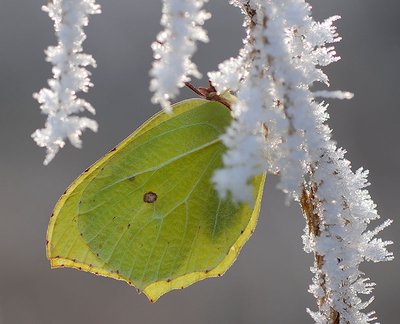The majority of butterflies overwinter as a caterpillar or pupa, however, only a few species overwinter as a butterfly. The most cold resistant of all is the brimstone butterfly. It is particularly rugged and can survive hard winters with barely any protection. How does this work? Nature equipped it with a special frost protection agent.
Stiff as a board as if it was frozen, exposed on twigs, shrubs or hanging on tree bark; this is how the tender butterfly defies the winter. Thanks to stored glycerin in its bodily fluids the brimstone butterfly doesn't freeze. Additionally, at the beginning of winter it will discharge a part of its bodily fluids and eliminates practically all the water that it doesn't need. In this way the brimstone butterfly can survive temperatures well below -10° C.
Brimstone butterflies will become active for short times even after exposure to a few warming rays of sunshine on warm winter days. Already in February/March the brimstone butterfly will fully wake from hibernation. After mating and oviposition in April its life cycle comes to an end. Only a few of the butterflies which have successfully overwintered live to see the emergence of the next generation and die shortly thereafter.
Source:
Jaun, A.; Joss, S.: Auf der Wiese. Natur erleben – beobachten – verstehen, Haupt Verlag 2011

